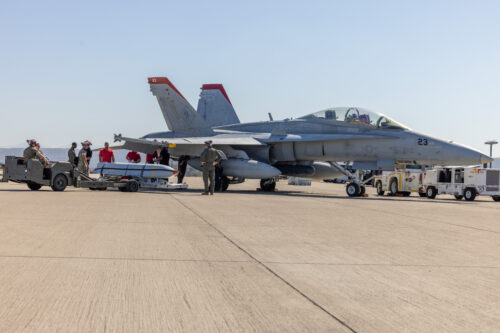The United States Marine Corps has successfully validated the integration of the AGM-158A Joint Air-to-Surface Standoff Missile (JASSM) on its F/A-18D Hornet aircraft. This achievement, accomplished by Marines from Marine Aviation Logistics Squadron (MALS) 11 and Marine Fighter Attack Squadron (VMFA) 232, took place at Marine Corps Air Station Miramar, California, on Aug. 27-28.

The AGM-158A JASSM, a conventional, stealthy, air-launched ground attack cruise missile with an impressive range of 230 miles, represents a quantum leap in the Hornet’s offensive capabilities. Major Bradley Kirby, an aviation ordnance officer with 3rd Marine Aircraft Wing, emphasized the strategic importance of this integration, stating, “The AGM-158A JASSM significantly enhances the Hornet’s capabilities, enabling it to strike targets from well beyond the reach of enemy air defenses.”
The validation and verification process, a critical step before the JASSM’s full incorporation into the Marine Corps arsenal, demanded meticulous attention to detail and technical expertise from the aviation ordnance technicians of MALS-11 and VMFA-232. Sergeant Kaleb Bents, serving as the quality assurance safety observer (QASO) for MALS-11, oversaw the intricate processes of transportation, safe weapon handling, and inspection. The loading procedure, software compatibility verification, and arming and dearming processes were expertly managed by Staff Sergeant Elijah Gilbert, the VMFA-232 QASO.
In an unprecedented move that underscores the significance of this integration, the validation and verification testing utilized a live AGM-158A JASSM, departing from the typical use of training missiles. This decision highlights the Marine Corps’ confidence in its personnel and the critical nature of the JASSM’s advanced capabilities. Staff Sergeant Holly Espinoza, munitions work center supervisor with MALS-11, noted the exceptional training value of the exercise, stating, “It was an excellent opportunity not only to learn about the JASSM, but also about how ordnance items are loaded onto the aircraft.”
The successful integration of the JASSM into the F/A-18’s weapons portfolio is just the beginning of a broader modernization effort within Marine Corps aviation. Plans are already in motion to incorporate even more advanced munitions, including the AGM-158B JASSM-ER (Extended Range) and the AGM-158C Long Range Anti-Ship Missile (LRASM), into the weapons integration roadmap for the F-35B/C platforms. These additions promise to dramatically enhance the Marine Corps’ ability to project power and influence in maritime environments.
Warrant Officer Josiah Hood, ordnance officer with VMFA-232, emphasized the far-reaching implications of this achievement, noting, “The JASSM validation and verification process allowed Marines to contribute valuable feedback that will inform the development of checklists to be used by both the Marine Corps and the Navy against future adversaries.”
As the Marine Corps continues to adapt to evolving global threats, the integration of advanced munitions like the AGM-158A JASSM represents a critical step in maintaining operational superiority. Major Kirby succinctly captured the transformative nature of this development, concluding, “This added capability will greatly increase 3rd Marine Aircraft Wing’s ability to support the joint force and enable greater freedom of maneuver across all operational domains.”
For more information, hit the Source below